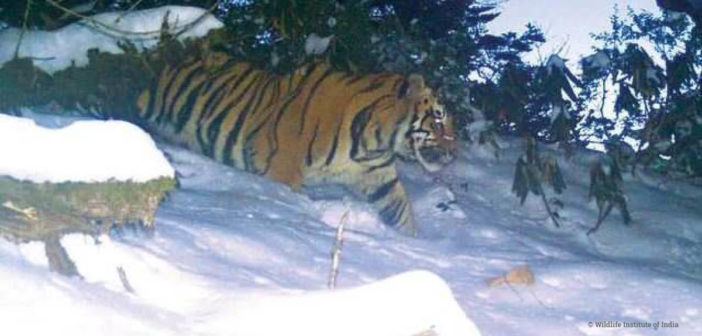Written by Debbie Banks, EIA Tiger Campaign Leader
An inspiring story from India caught my eye as I recently headed to the 3rd Stocktaking Conference on Tiger Conservation in New Delhi, the story of the Idu Mishmi people of India’s north-east Arunachal Pradesh and tigers.
Recent media coverage has reported the presence of a tiger population in the Idu Mishmi’s ancestral homeland of Dibang Valley. These tigers reach impressive altitudes of 3,600 meters and feed on a unique prey assemblage composed of Mishmi takin, serow and Gongshan muntjac.
The media quickly dubbed Dibang tigers as India’s ‘snow tigers,’ but perhaps they should be called ‘Idu tigers.’ What makes these tigers truly unique isn’t just that they are such formidable mountaineers but the very reason for their existence in Dibang Valley – the Idu Mishmi people themselves.
For the Idu Mishmi, the tiger is their brother. Idus believe that they and the tiger came from the same ancestral parents, that the tiger is a brother they do not harm and have learnt to live with. In addition to being regarded as their brother, the tiger is also the most powerful spiritual force from which Idu priests seek power and protection.
Scientific analyses have estimated as many as 52 adult tigers in Dibang Valley, up to 90 per cent of them living in the Idu people’s community forests, while the official wildlife sanctuary in the region supports only a very small fraction of them, another testament to this special relationship between man and animal.
In order to save the Idu tigers, this exceptional relationship must also be preserved.
The Idu have recently gone on record to say that they would like to conserve their own tigers and, in order to ensure that these tigers thrive, they argue for a new cultural model that isn’t built around guns and guards.
The story of the Idus’ relationship with the tiger is complex, deep-rooted and unique, but there are still exciting lessons to be learnt from their knowledge and experience. Firstly, they challenge existing understandings of human-tiger conflict and, secondly, they highlight the need for multiple tools to save the tiger. Law enforcement must go hand-in-hand with cultural models of conservation in places where they have proven effective.
The tiger is not only a symbol of pristine wilderness, it is also a symbol of India’s cultural heritage. In a country so remarkably diverse, models to save the tiger may be just as diverse, and the inclusion of, and reliance on, local people in tiger conservation is indispensable, particularly in India where cultural links with tigers have existed for millennia.
Featured image: a camera trap caught this image of a tiger trekking through the snows of the Dibang Valley, India. Image credit Wildlife Institute of India.







